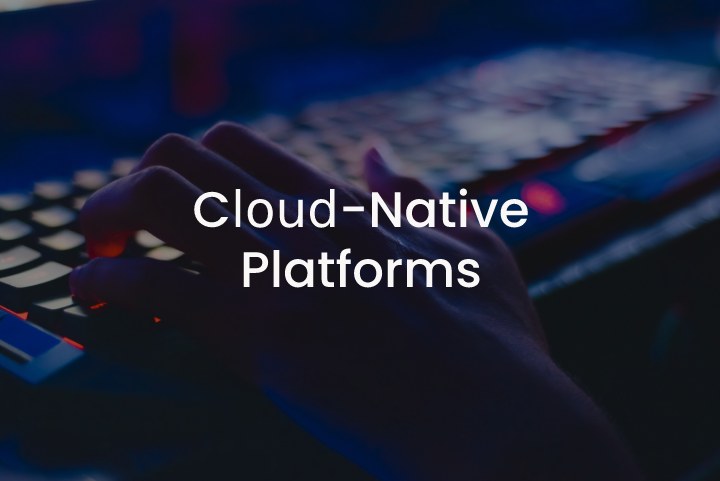Implementing Data Analysis for Operational Optimization and Increased Business Performance
Businesses today have access to more data than ever before, from customer transactions and interactions to operational metrics and financial …
 14 | 10 | 2022
14 | 10 | 2022 It all started with the term “cloud computing” and it has only lately acquired prominence as a tool for increasing a company’s efficiency and flexibility. Furthermore, the Covid-19 pandemic and the rapid digital change have made cloud computing more vital than ever. What exactly are cloud-native platforms (CNPs)?
To begin, to comprehend cloud-native systems, we must first understand cloud computing. Cloud computing is also known as cloud technology and is colloquially known as the cloud. Essentially, cloud implementation is determined by the sort of cloud computing architecture and cloud computing services used.
For computer services to be delivered, there are three types of cloud computing or cloud architecture:
Public cloud — A cloud architecture owned and maintained by a cloud service provider, to which customers must log in using web browsers.
Private cloud — A cloud architecture utilized just by one organization, with services and infrastructure hosted on a private network.
Hybrid cloud — A cloud architecture that blends private and public clouds.
Infrastructure as a service (IaaS) – A computing service that offers consumers computation, connectivity, and storage capabilities.
Platform as a service (PaaS) — A computing service that provides a platform and IT infrastructure to consumers for them to execute applications.
Software as a service (SaaS) — A computer service that offers customers a cloud application and platform on which to execute the apps, as well as the platform’s underlying infrastructure.
Based on its widely used on-premises software solutions, Microsoft provides outstanding cloud services.
‘Cloud-native technologies allow organizations to design and execute scalable applications in modern, dynamic settings including public, private, and hybrid clouds,’ according to data published by Cloud Computing Foundations. This approach is exemplified by containers, service meshes, microservices, immutable infrastructure, and declarative APIs.
A cloud-native application is a software designed expressly for use in a cloud computing system. These apps are run and hosted in the cloud, allowing them to make use of the inherent features of cloud computing software delivery paradigms. A native app is a software that is created expressly for a platform or device. Cloud-native technologies are used by 41% of the 16.6 million back-end developers, a decrease from the previous year.
As a result of this knowledge, cloud-native platforms may be defined as techniques that allow organizations to create new architectural applications that make use of cloud benefits. Cloud-native platforms offer solutions that can help provide a more efficient and robust IT foundation through safe data integration and processing since cloud-native technology is all about speed and agility.
Cloud-native technologies have sparked a rush of interest, and many businesses increasingly rely on them to launch goods and services. The Cloud Native Computing Foundation has produced several open-source solutions that make cloud computing easier. We’ll look at some of the more often utilized ones below.
Kubernetes (commonly known as k8s or “Kube”) is an open-source container orchestration platform that automates many of the manual tasks required in the containerized implementation, monitoring, and scaling.

Prometheus is an open-source tool that provides tracking and reporting for cloud-native systems such as Kubernetes. In 2016, the Prometheus project joined the Cloud Native Computing Foundation, following Kubernetes. It contains a strong query language (PromQL) and a many-faceted data model that is appropriate for keeping time series data.

Istio is an open-source service mesh that overlays current distributed applications invisibly. The strong capabilities of Istio give a more consistent and efficient approach to protecting, connecting, and monitoring services. Istio enables load balancing, service-to-service authentication, and monitoring with minimal or no service code modifications.

Cloud-native apps are built with a specific goal in mind. Dedicated and small feature teams create and deploy these apps fast on a platform that allows for easy scaling and hardware decoupling. Businesses gain from increased portability, resilience, and agility in their cloud systems as a consequence.
We’ve looked at some of the most popular cloud-native applications today. The Cloud-Native Computing Foundation is currently incubating some different apps and initiatives. We may see a boom in interest in cloud-based services and container-based systems in the next years. There will be a growth in the number of cloud-native technologies as more sectors choose to embrace cloud-based architectures.
After all of this, we hope you found this post interesting. Comment below if you know of any more cloud computing applications or if you think we should add more cloud computing topics to this page. If you want your buddy to read this, don’t forget to share it on social media.
READ ALSO: HOW TO USE MICRO-FRONTEND TO CREATE A SUCCESSFUL PRODUCT FOR YOUR BUSINESS
Businesses today have access to more data than ever before, from customer transactions and interactions to operational metrics and financial …
Conversational AI systems can engage in natural conversations and dialogue with humans. Powered by machine learning and natural language processing, …
The decision between hiring a software development company or a freelancer can be challenging for business owners who are looking …